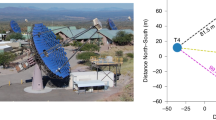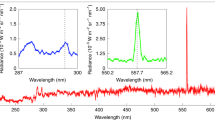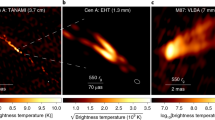Abstract
As a result of the observations of Blackwell and Ingham1 it is now believed that the zodiacal light is almost entirely due to the scattering of sunlight by dust particles concentrated into the plane of the solar system. Because of the orbital velocities of these dust particles, the Fraunhofer absorption lines in the spectrum of zodiacal light should show Doppler shifts. During June–August of 1962, observations were made at Chacaltaya (long. 68° 68′ W.. lat. 16° 21′ S., alt. 5.5 km) to measure this Doppler shift for the Hβ Fraunhofer line, using a specially constructed, high-luminosity, photoelectric spectrometer. The spectrometer was of the Ebert type, with the resolving power or luminosity increased by using it in series with a large Fabry–Perot etalon2. The addition of the etalon improved the performance of the system by a factor of 10 over the best that could be realized from a conventional spectrometer design. The etalon plates were of 90 mm useful diameter, polished by Hilger and Watts, Ltd., so that the gap was uniform to better than λ/50 at 5461 Å, and coated by Grubb Parsons with seven-layer dielectric reflecting coatings. The etalon was enclosed in a pressure vessel which could be filled to a controlled pressure with propane gas. This made it possible to vary the refractive index in the gap between the etalon plates and so change the order of interference, and hence the wave-length, passed by the interferometer. The Fabry–Perot fringes were focused by a plano-convex lens of focal length 47.5 cm on the entry slit of the Ebert spectrometer, which utilized mirrors of focal length 68 cm and a 128 mm by 208 mm plane grating (Bausch and Lomb No. 33–53–27–57) worked in fifth order. The grating of the spectrometer was imaged through the exit slit on to a photomultiplier (E.M.I. 6256 S), especially selected for low dark noise, which fed a pulse counting system with digital output.
This is a preview of subscription content, access via your institution
Access options
Subscribe to this journal
Receive 51 print issues and online access
$199.00 per year
only $3.90 per issue
Buy this article
- Purchase on Springer Link
- Instant access to full article PDF
Prices may be subject to local taxes which are calculated during checkout
Similar content being viewed by others
References
Blackwell, D. E., and Ingham, M. F., Mon. Not. Roy. Astro. Soc., 122, 129 (1961).
Geake, J. E., Ring, J., and Woolf, N. J., Mon. Not. Roy. Astro. Soc., 119, 616 (1959).
Mack, J. E., McNutt, D. P., Roesler, F. L., and Chabbal, R., App. Optics, 2, 873 (1963).
Author information
Authors and Affiliations
Rights and permissions
About this article
Cite this article
RING, J., CLARKE, D., JAMES, J. et al. Profile of the Hβ Line in the Spectrum of Zodiacal Light. Nature 202, 167–168 (1964). https://doi.org/10.1038/202167b0
Issue Date:
DOI: https://doi.org/10.1038/202167b0
This article is cited by
-
Zodiacal light ? A measure of the interplanetary environment
Space Science Reviews (1975)
-
Motion of the Interplanetary Dust Cloud
Nature (1970)
-
Structure and evolutionary history of the solar system, I
Astrophysics and Space Science (1970)
-
Radial Velocity Measurements on the Zodiacal Light Spectrum
Nature (1968)
Comments
By submitting a comment you agree to abide by our Terms and Community Guidelines. If you find something abusive or that does not comply with our terms or guidelines please flag it as inappropriate.



